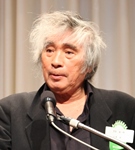December 10, 2014
Mr. Seiichiro Kuboshima
Owner of Mugonkan, Museum of the war dead art students
Writer
�� I run a small art museum called Mugonkan (voiceless museum), located at the edge of Ueda City in Nagano Prefecture. I opened this museum receiving neither governmental subsidies nor tax incentives
I run a small art museum called Mugonkan (voiceless museum), located at the edge of Ueda City in Nagano Prefecture. I opened this museum receiving neither governmental subsidies nor tax incentives
��The Sino-Japanese War and the Pacific War claimed many lives. Over 3 million Japanese soldiers were killed, while victims in neighboring Asian countries are estimated to total 20 to 30 million. Among such soldiers were young art students who wished to become painters should they have survived the War. I visited 87 bereaved families throughout Japan over nearly 4 years to borrow their paintings to be displayed at Mugonkan. The museum now stores 177 works of 108 art students and I would like to touch upon some in my speech today.
��Yasunori Hidaka was from Tanegashima Island, Kagoshima Prefecture. His hometown was at the southern end of the Island where the Space Center of Japan Aerospace Exploration Agency is located. After graduating from the Tokyo School of Fine Arts (currently Tokyo University of the Arts) in 1942, he was drafted to the front and died in service at the age of 26 at Luzon Island, the Philippines. Yasunori��s younger brother recalled the day of Yasunori��s departure. He devoted himself to the canvas, working with his oil paint brush over the sketch of his sweetheart up to the very last minute. Visitors to Mugonkan will find this beautiful portrait of a naked woman that emerges like a bodhisattva or goddess in a dim light. At the back of the canvas are his last words: ��I shall come back alive to finish this work.��
��Manpei Nakamura, from Hamamatsu, Shizuoka Prefecture, was also a student of Tokyo School of Fine Arts. He chose to die rather than surrender in Manchuria at age 27. He went to the front, leaving behind his pregnant wife Shimoko. Sadly enough, Shimoko passed away 6 months after giving birth to a baby boy. Manpei had sent a postcard with a sketch of a baby��s sleeping face with long curled up eyelashes. It looks so peaceful and sweet. There is an incredible story behind this work. Gyosuke Nakamura, born in 1941 just like myself, is the son of Manpei. Now in his 70s, after retiring from a major company, Gyousuke looks identical to the baby drawn on the postcard. Manpei fell in battle without seeing his beloved son, but his work expresses his profound affection, prayer and wish for his child. Manpei left a portrait of a naked pregnant woman displayed at Mugonkan. Gyosuke claims it to be a portrait of a mother and child as he was in his mother��s womb.
��Kiyoshi Hachiya taught himself how to paint. He died in Leyte Island, the Philippines, in 1944 at age 20. After getting his mobilization notice, he drew his grandmother Natsu within 10 days before his departure. Natsu used to give Kiyoshi a piggyback and sing nursery songs in his childhood. Kiyoshi left a detailed portrayal of Natsu with gray hair, wearing a bright red hanten (traditional Japanese winter short coat). Natsu remembered how desperately Kiyoshi worked over his painting. She told him to come back alive and complete his work on Natsu. Maybe he was prepared to meet his fate as he had left a clear signature on his work before departure.
��Another student I want to introduce is Osamu Sakuma who was killed by the B-29 bomber at the age of 29 while he was mobilized to work at the aeronautical institute in Nagasaki. The night before Osamu left for Nagasaki, he asked his newly-wed wife Shizuko to be a model for his paintings. Shizuko later recalled how shy she had felt then. Osamu left two small portraits of his 22-year-old wife, a nude sketch and Shizuko in a kimono with slightly downcast eyes. Shizuko passed away about 10 years ago at age 84 at Kokura in Kyusyu. She was a sweet granny with fair complexion. I confess Shizuko gave me a little hard time as she changed her mind several times before leaving Osamu��s works to Mugonkan and therefore I had to visit Kokura several times. She wished to visit Mugonkan and watch Osamu��s works on display, but I regret to say she passed away before the museum was completed.
��Mugonkan has appeared on newspapers and TV, always with anti-war slogans that call on ��to protect peace�� or ��never to repeat those times of absurdity.�� The paintings at Mugonkan make us have a renewed sense of how precious peace is. But let me emphasize the paintings were not drawn to appeal on pacifism. They convey us a more personal profound message, the intimate relationships built with one��s beloved wife, sweetheart, parents or adorable little sister and how grateful one felt for the support and affection one had received from people around. The paintings are the proof of one��s youthful life.
��Today, we live in a time of parricide and infanticide. I believe the deceased young art students are not only making accusations of the war but also questioning how we have lived the 70 years after the War, how much we have lost something irreplaceable and how we should face the future.
��After graduating from high school, I opened a small bar amidst the high economic growth period, dreaming to become a painter myself. But I ended up in failure. I opened Mugonkan with the hope to collect paintings that I love. I look forward to welcoming you to the museum that stands quietly among the trees.